
The BRITE-Constellation satellite mission will obtain accurate photometry for the brightest stars in the sky. One may wonder why, because it seems logical that the brightest stars are also the best-studied ones. This is not always the case: for modern astronomical instrumentation, many stars are often too bright! For instance, in a precursor study for BRITE Gerald Handler and Aleksander Schwarzenberg-Czerny recently showed in a paper "Time-resolved multicolour photometry of bright B-type variable stars in Scorpius" that Lambda Scorpii (Shaula, the star at the tip of the sting of constellation Scorpius and after all the 25th brightest star in the sky) is probably 30% more massive than previously thought. Shaula is also a known stellar triple; the present study shows that one of the orbital periods in the literature was incorrect. It was also found that the bright eclipsing binary mu1 Sco features mutual heating of the stellar hemispheres facing each other in the ultraviolet. This effect was predicted by Polish astronomer Slavek Rucinski more than 40 years ago and now seen for the first time. Future BRITE observations will certainly reveal many more secrets the brightest stars still hide.






